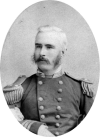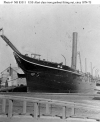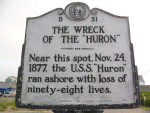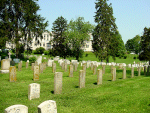Click on thumbnail
for full size image |
Size |
Image Description |
Source |
|---|
 |
116k |
Commander George P. Ryan was born in Massachusetts, May 8, 1842. He was appointed from the State to the Naval Academy Sept. 30, 1857. He was graduated with honor in 1860. In 1861 he was attached to the brig Bainbridge as Midshipman and from 1862 to 1865 was on special duty on the steam-sloop Sacramento. He received his commission as Lieutenant July 16, 1862. In 1865 and 1866 he was an officer of the steamer Lenapee. He was commissioned Lieutenant Commander July 25, 1866. From 1867 to 1869 he was Professor of Physics and Chemistry and from 1871 to 1872 was the Professor of Natural and Experimental Philosophy at the Naval Academy. Subsequently he was sent on special service in the frigate Sabine. On September 19, 1874 he was made a full commander. He was assigned duty on the Swatara in the American expedition to observe the transit of Venus, and had charge of a station in the Indian Ocean. On his return he was given the command of the Huron. He had gained a very high reputation in the service, and was regarded as an exceedingly capable officer. The Huron, built with funding authorized by the 42nd Congress, was a Federal gunship. Built after the Civil War in 1874 and commissioned in November 1875, the Huron was powered by both sail and steam, was 175 feet long, displaced 541 tons and carried four 9 inch guns. On November 23, 1877 she departed from Hampton Roads for the coast of Cuba on a scientific expedition. Her complement of 116 men and 15 Marines were all hand picked. She headed south out of the Chesapeake Bay and down the East Coast. As she passed by the Cape Henry Light around midnight, all aboard knew the predictions of bad weather had been correct. The sea grew rougher and the wind gained strength, forcing the ship leeward 10 degrees. Nevertheless, the Captain, Commander George P. Ryan, chose to continue onward while hugging the coast. That soon proved to be the wrong choice. By 1:00 A.M., with the winds now at gale force, the ship was hitting bottom on the sand bars off Nags Head. The striking of the hull on the sand, the wind, and the waves all conspired to doom the ship. Eight officers and seventy-five crew members perished which included her captain Commander Ryan. Only 34 of her crew survived. The large loss of life was due in part to the fact that no one who saw the repeated flares and rockets that signaled for rescue, could help. In terms of lives lost, the Huron was one of the worst wrecks off the North Carolina coast. Although the Life Saving Service had been started three years prior to the Huron running aground, due to massive under funding the Service only manned stations in North Carolina for three winter months beginning December 1; one week to late to be of help to the crew of the Huron. The outrage over the Huron tragedy prompted Congress to fund the Service year-round. The Life Saving Service eventually evolved into the modern U.S. Coast Guard |
Bill Gonyo |
 |
272k |
Naval History and Heritage Command photo from "Warships of The Civil War Navies" by Paul H. Silverstone |
Robert Hurst |
 |
182k |
Photographed while fitting out, circa 1874-75. The three ships of this class were Alert (1875-1922), Huron (1875-1877) and Ranger (1876-1940)
Naval History and Heritage Command photo NH 85311 |
Bill Gonyo |
 |
314k |
Line engraving from "Fag Ends", 1881, depicting the ship's loss near Nag's Head, North Carolina, on 24 November 1877
Naval History and Heritage Command photo NH 53410 |
 |
175k |
Historical Marker at Nag's Head, NC |
 |
309k |
The crew members originally buried in North Carolina were eventually moved the United States Naval Academy Cemetery. In section five, 60 sailors from the wreck of the Huron are buried together in the United States Naval Academy Cemetery. The body of Commander Ryan was recovered and brought to his home in Boston, Mass. The funeral took place December 6, 1877
Photo courtesy of the United States Naval Academy |
 |
44k |
A 9" Dahlgren gun recovered from Huron's wreck off Nags Head, North Carolina. Now on display in Gosport [Norfolk] Navy Yard, Portsmouth Trophy Park
Photo courtesy Naval Sea System Command |
Delta Squad |






